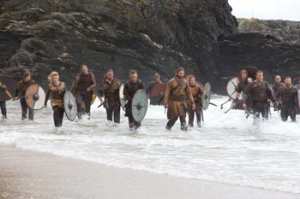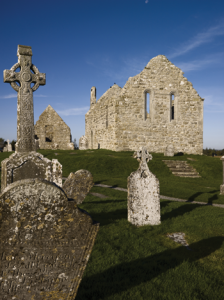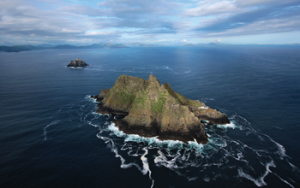Ireland in the Viking Age
Published in Features, Issue 2 (March/April 2014), Volume 22
Above: A Viking raid as depicted in Michael Hirst’s TV series Vikings, filmed on location at Silver Strand, Co. Wicklow. (History Channel)
We should not underrate the very real power of the Norse, and their physical and psychological impact upon the Irish people. Scholarship on the Vikings in Ireland, impressed (as we must be) by the technology of their ships and long swords and axes, has emphasised their technical superiority. This was allied to a superficial examination of Irish politics and society that viewed Ireland as a ‘tribal’ society with hundreds of tribes and was used as an explanation for the ultimate failure of the Norse to conquer large parts of the country, since as soon as one tribe was defeated they had to go on to defeat another. It used to be argued that the Normans introduced urban life in the twelfth century. The excavations at Dublin and subsequently in other towns showed that Viking emporia grew into towns during the course of the tenth century and from this it was argued that urbanism was introduced by the Vikings, even though they had no towns in their homelands when they first arrived (although they did have emporia—important trading places).

Clonmacnoise, Co. Offaly—an entry in the Annals of Ulster under the year 845 confirms that the Vikings rampaged throughout the central midlands and plundered and burned Clonmacnoise. (Tourism Ireland)
Attacks on Iona and elsewhere
The first reference to the Vikings in the Annals of Ulster occurs in 794—it is just one of eight entries recording the deaths of clerics in Armagh, Bangor, Clonmacnoise and Toomgraney, the death of the female head of Cloonburren (Roscommon), the taking of relics on circuit, a killing, a hosting by the high-king and the Leinstermen into Munster, the invasion of the Louth area by the northern Uí Néill king (nothing unusual so far) and then the simple statement: ‘Devastation of all the islands of Britain by heathens’. This was the start of it.
In 795 the islands of Skye and Rathlin were laid waste. In 798 Inishpatrick (Church Island) off Skerries was attacked and the shrine of the saint was broken; the marauders took a cattle tribute from the territories on the mainland and plundered in both Ireland and Scotland. More was to come. In 802 Iona was burned and 68 of the community were killed in 806. In the same year the Book of Armagh was being written. A drawing of the Heavenly Jerusalem follows the text of the Apocalypse. In the margin opposite the text of the Gospel of Mark describing the destruction of the temple of Jerusalem the scribe, Ferdomnach, wrote in Greek letters the name Cellach, the abbot of Iona at that time. The Irish monasteries were a reflection of the Heavenly Jerusalem and the destruction of Iona caused a profound shock. Armagh gave land at Kells for the refugees from Iona. The cross of Patrick and Columba at Kells commemorates their alliance. A new ‘city’ was begun at Kells, Constructio novae ciuitatis Columbae Cille hi Ceninnus, as recorded in the Annals of Ulster. Having seen the new templum of the Lord (‘the seat of justice for the oppressed’) to its completion in 814 Cellach resigned, making way for the new abbot. There was hardly a more fitting time for the creation of the Book of Kells—to adorn the altar of the new monastery at its dedication.
The abbot of Iona, Blathmac mac Flainn, was martyred by Vikings on 24 July 825, and in a poetic ‘life’ composed by Walafrid Strabo, abbot of Reichenau (a monastery well known to the Irish), we are told that the monks, in an-ticipation of the attack, lifted the shrine of St Columba from its pediments and buried it in the earth under a thick layer of turf. Following the raid on the churches in Wexford Harbour in 821 the Norse occupied the islands there; and the shrines of SS Erdit and Augustine were taken inland to Sletty (on the Barrow, 1.5km north of Carlow town) for safety. In the same year, during an attack on Bangor the Norse broke into the church and shook the bones of St Comgall from their shrine. The bones were subsequently gathered up and taken inland to the church of Antrim. In 1122 the Annals of Ulster state: ‘The shrine of Colmán son of Lúachán was found in the burial place of Lann (parish of Lynn on north-east shore of Lough Ennell), a man’s cubit in the earth, on Spy Wednesday (March 22nd)’. The ‘life’ of the saint tells us that the shrine was buried during the time that Tuirgéis was raiding throughout the midlands before his execution in 845.
Also in the fateful year of 821 Howth was raided and a great number of women were led into captivity. Raids on settlements for slaves—men, women and children—became commonplace. Those people who had status in church or society were held for ransom. Some, such as the hermit Étgal, who was taken from Skellig Michael (that pinnacle of rock off the coast of Kerry) in 824, died from hunger and thirst at their hands. Most of the references above were to coastal raids. The activity of Tuirgéis indicates that by the mid-ninth century the Vikings were using the river systems and the great lakes to penetrate to the very heart of the country. There can be no doubt that in the first half of the ninth century the Vikings had a profound impact upon the Irish. But how much disruption did it bring to society?
Ireland not ‘tribal’

Above: Skellig Michael, off the coast of the Dingle peninsula, Co. Kerry—its hermit, Étgal, was taken for ransom by Viking raiders in 821, and died from hunger and thirst at their hands in 824. (Tourism Ireland)
Society in Ireland on the eve of the Viking attacks was far from at a ‘tribal’ stage. There were many petty kingdoms, of course, and many were to survive for a very long time, but they had little independence and were increasingly simply districts within larger powerful political kingdoms. While the petty kings controlled their own communities, their political function was as officers of the greater kings. Ireland was wealthy in people, animals and agricultural production. It was extremely attractive as a source of plunder and as a place for colonisation. There were places where wealth was concentrated—notably in the residences of kings and lords, but above all in churches. Church settlements were not isolated from the world. The larger were like small kingdoms in their own right, with a considerable population at the core but which was also spread over the properties that they owned. They had a capacity to produce a surplus of food. The aristocracy that ruled them was, in most cases, related to the local kings—and ecclesiastical and secular power went hand in hand. Some of the larger church settlements were beginning to show urban characteristics; indeed, the churches were becoming the towns and villages of early Ireland.
Despite the increase in raids during the first half of the ninth century it was politics as usual. The Northern Uí Néill followed their policy of subduing Leinster, dividing the province on a number of occasions. As the activity of Tuirgéis shows, by the mid-ninth century the Norse had penetrated to the very heart of the country. The possibility that large parts of the island might have been conquered came to an end with a series of major Irish victories in the midlands, Leinster and Munster in 848. From this point on, Norse settlements were confined to the coast, and slowly they were drawn into the political strategies of the Irish. There had been intermarriage already but this was to increase as part of the political manoeuvring of the various parties and probably contributed to the Christianisation of the Norse.
Changes had been taking place in Irish society before the coming of the Norse. These changes were accelerated because of their presence. Norse trade (particularly the slave trade) brought great wealth to Ireland. When Irish kings gained access to this it allowed for the increasing militarisation of society, and kingdoms became larger and fewer in number. By the mid-tenth century Dublin had emerged as a planned town engaged in international trade. Its king, Amlaíbh Cuarán, sought to rule in the Irish fashion, and after the death of the high-king, Congalach Cnogba, in 956 he became a serious player in the midlands. While the Norse of this period may not have been capable of colonising large areas, they were capable of putting large areas under tax.
The Uí Néill dynasties of the north and the midlands dominated Ireland. But the emergence of an obscure people, the Dál Cais, in south Clare from the mid-tenth century onwards (largely owing to their access to the wealth of Viking Limerick) set the scene for the shape of Irish politics until the coming of the Normans. Control of international trading ports was now more important than the expulsion of Vikings. Brian Boru was only too well aware of this before Clontarf.
Charles Doherty is a senior lecturer in the School of History and Archives, University College Dublin.
Read More: What the sources say
Technology
Further reading
C. Doherty, ‘The Vikings in Ireland: a review’, in H.B. Clarke, M. Ní Mhaonaigh and R. Ó Floinn (eds), Ireland and Scandinavia in the early Viking Age (Dublin, 1998).
D. Ó Cróinín, Early medieval Ireland 400–1200 (London, 1995).
















